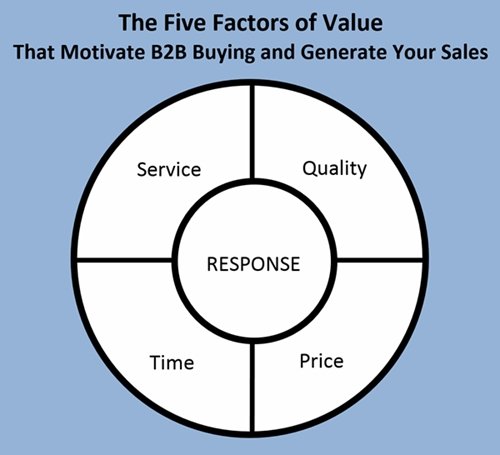In our B2B marketing guidebook Business-to-Business Marketing: A Step-by-Step Guide, my co-author Charlie Stewart and I write, "The purpose of B2B marketing is to attract and retain profitable customers."
To achieve that purpose, it's critical to understand what motivates customers to buy your products and services.
The third of this short series of articles offers straightforward guidance on how to...
- Identify what your customers value
- Understand how value motivates B2B buying
- Break through the price barrier using customer insights that matter
- Use value to justify your pricing: i.e., focus on creating value
Identify the Criteria That Motivate Customers to Buy—and Keep on Buying
Customers buy Value. With a capital V. Their buying is motivated by all the ways your offering contributes to their success—i.e., how you create Value for them.
So what do customers value? Perhaps they are motivated by price or lead times. Or by product quality or service levels. Maybe they select suppliers who understand their challenges and respond with solutions to address them.
In B2B markets, Value can be divided into five factors:
- Response
- Service
- Time
- Quality
- Price
Each factor can be defined. Which means it can be measured. And when Value is measured in terms of its importance to customers, it can be managed, improved, and delivered in ways that will motivate customers to buy.

Value motivates buying. Its five factors are therefore buying motivators. They are the reasons customers prefer and select one supplier rather than another.
Defining the Five Factors of Value that Motivate Buying
To begin the process of describing how you create Value, it's important to keep the following definitions in mind. It also helps to think of them as expectations that customers have of your company.
1. Response
- A focused dialogue with customers: understanding how you contribute to their success
- Identifying and meeting customers' changing needs
2. Service
- Accessibility: an open and reassuring organization
- Clear information on products, services, processes, and project status
3. Time
- Dependable lead times
- Consistent delivery format
4. Quality
- Consistent products, services, and processes
- Meets the brief or specifications: achieves the customer's goal
5. Price
- Clear
- Structured
- Rational
- Competitive
Any B2B product or service can be described in terms of the Big Five. Which means that what you are really selling can be positioned and promoted according to what customers are really buying.
Value in Action. How the Big Five Motivate Buying: My Kingdom for a Horse!
In the Shakespeare play The Tragedy of King Richard the Third, Richard loses his horse in battle and is severely disadvantaged by having to continue the fight on foot. In desperation, he cries out: "A horse! A horse! My kingdom for a horse!"
To understand Value in action, think of Richard as a customer. What does he need in terms of The Big Five?
- Response is critical to Richard. He needs to know that someone understands his challenges and will solve his pressing problem.
- As for Service, what he doesn't need is a detailed project-status report telling him that a horse will definitely arrive before close of battle today.
- Time definitely matters to Richard. Although he doesn't say specifically when he needs a horse, you know when he needs one: now, with an exclamation mark! Above all else, rapid supply is what he values most right now.
- Is he bothered about the Quality of the horse? Well, yes and no. He's not interested in its features and benefits. He couldn't care whether it's a carthorse or a racehorse, armored or saddled. Or whether it's a gray mare or a black stallion. In terms of Quality, a living horse with a bit of go left in it will do.
- As for Price, Richard makes it crystal clear that it's not an issue. To him, total cost of ownership, return-on-investment, discount structures, and payment terms are totally irrelevant. He's certainly not concerned that the price be competitive: Horses don't normally sell for the price of kingdoms. Which highlights the fact that what customers value changes according to the circumstances affecting them.
Richard's story also shows that customers don't always spell out exactly what it is they really value. So you need to find out. Through a focused dialogue with customers, you need to develop accurate insights into all the ways you create Value that motivates them to buy from you.
Break Through the Price Barrier by Using Customer Insights That Matter
When the Big Five are listed in order of their typical importance to customers, Response is at the top, followed by Service, Time, Quality, and Price.
So, if it's last on the list, why all the fuss, all the time, about Price? To answer that question, it helps to see Price as a mechanism for measuring the extent to which the other four factors contribute to a customer's success.
When customers don't appreciate the significance of those other contributions, Price always becomes a barrier to sales and a threat to margins. Customers will not pay for aspects of products and services that do not create demonstrable Value. That blunt fact reinforces the importance of customer insight.
Far from being some silly buzz-phrase, customer insight is essential if you want to understand how Value generates sales, protects margins, and sidelines competitors.
Understanding the Nuts and Bolts of Creating Value
To illustrate how products and services translate into benefits that create Value, let's say that a company called AirCo makes airplanes and buys its nuts, bolts, and washers from a manufacturer called NuBoCo.
A bolt with a matching nut and washer is not a complex system. Calling it something pretentious like an "integrated aeronautical fastening solution" doesn't add to its complexity or its monetary value—it's still a nut, a bolt, and a washer. So how does NuBoCo create the value that motivates AirCo to buy—and buy at a premium?
- AirCo knows that if the propeller mounting bolts fail, the propellers will fall off. Not good... The Quality of NuBoCo's products is critical because it ensures the integrity of AirCo's planes, safeguards the passengers they carry, and protects the company's reputation. Quality is a powerful motivator for buying NuBoCo's range of internationally certified aerospace products.
- Without timely supply from NuBoCo, AirCo can't assemble its planes and sell them. AirCo's cash flow suffers if it can't meet commitments to customers. Late-delivery penalties are incurred, margins are diluted, and its reliability as a manufacturer is undermined. Time matters to AirCo because it creates continuity in manufacturing and sales fulfillment. NuBoCo recognizes this and guarantees its stockholding levels and monitors demand within AirCo's factories.
- Around the world, AirCo's customers use NuBoCo products in their scheduled maintenance programs. To reduce downtimes and ensure regulatory compliance, NuBoCo provides agreed minimum levels of Service through its channel of trained, accredited, and performance-audited distributors.
- The next generation of AirCo's planes will keep the company ahead of its competitors. Manufacturing these planes will require a different range of nuts and bolts. In terms of Response, NuBoCo further demonstrates its commitment to understanding and fulfilling AirCo's requirements by providing a research and development service; manufacturing and testing prototypes; and by co-operating closely with AirCo's designers and engineers.
Clearly, NuBoCo is selling a great deal more than the products it makes. The extent of its contribution to AirCo's success ranges from assuring safety and processes to technical support, certifications, guarantees, and product development.
Value Always Justifies Price
The combined Value delivered by NuBoCo is reflected in the premium price that AirCo is willing to pay over and above the going rate for undifferentiated nuts, bolts, and washers: Value justifies Price. And it is the only justifier.
For AirCo, price is not a significant buying motivator. It is, however, a very significant measurement. It measures the extent to which NuBoCo's products and services are competitive in terms of the Value they create.
If another supplier can prove to AirCo that it will create more Value for the same or less money, then NuBoCo will either have to compete on a like-for-like basis or accept being shown the door.
To outperform your competitors and attract and retain profitable customers, it is essential to maintain accurate, current insights into all the ways you can and will create Value for every one of your customers.
Articles in this series:




